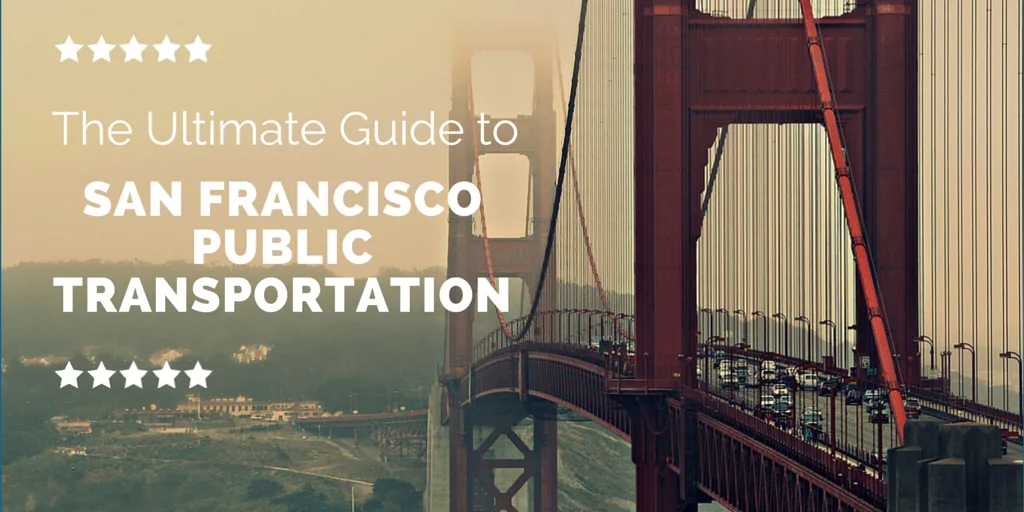
It’s easy to fall in love with San Francisco: it might be the hills, the Victorian houses, and the aroma of fortune cookies that lingers in the air, or maybe the hippie atmosphere, but there’s something truly captivating about it.
Many tourists who plan to visit the city for the first time wonder if they should drive or not.
Trust me, you don’t want to drive around San Francisco, even if you drove from LA to San Francisco: traffic is a nightmare, finding a parking spot is like winning the lottery, and even if you find one, have you ever tried parallel parking on a steep hill? Plus, we all want to be sustainable, right?
Luckily, San Francisco is a well-put-together city with a wide array of public transportation networks that really make it easy to leave that car at home. From buses to cable cars, metro, and light rail, let’s check your options out one after the other.
Here you’ll find a comprehensive guide to San Francisco public transportation. Let’s check it out!
Table of Contents
GENERAL TIPS
Like any other city, if you are planning on relying on public transportation while in San Francisco, it helps to be located in a central, well-linked neighborhood. With so many things to do in San Francisco, you will move a lot.
You might want to look for a hotel in Union Square or Fisherman’s Wharf so it’ll be easier to move around than if you were located for example, near Van Ness, Lombard Street, or the Golden Gate area.
San Francisco is like any other big city, and some neighborhoods are safer than others: this is just common sense, but avoid going to rough places after dark and listen to your gut whenever and you won’t have any problems.
Pay a little more attention at night time: if you are a girl alone and/or you feel uncomfortable, you might want to sit or stand closer to the driver.
If you prefer to download an app to use on the go from your smartphone, check out this list of San Francisco Transportation Apps.
Another option, Google Route Planner on Google Maps does the trick as well (pss! it works all around the world!).
If you’re planning to visit San Francisco without a car, no worries. The transportation system is very good, so anywhere in the city center is a good area to stay in San Francisco.
Check out the best prices for San Francisco hotels here.
HOW TO RIDE THE MUNI NETWORK
The San Francisco Municipal Transportation Agency, which is normally referred to as Muni, is the main San Francisco public transportation agency, and the one that most tourists use to get to their destinations.
Its huge network of trolleybuses, buses, cable cars, and streetcars makes it possible to get around easily and quickly around the city.

Passengers who prefer to pay cash for the Muni use will have to ask the driver before boarding the bus, streetcar, or trolleybus.
Tickets must be shown to fare supervisors when requested; you are liable to a fine if you’re unable to show proof of payment. Passengers who pay cash for the cable car use will be issued a receipt too, and this also serves as proof of payment.
The Muni also offers ‘Passports’ that range from 1 day ($14), to 3 days ($33) and 7 days ($44). These passports give you unlimited rides on trolleybuses, San Francisco buses, cable cars, and streetcars for the purchased number of days.
If you’re planning on moving around a lot, the use of passports offers some convenience as you can jump on the bus or the streetcars any time of the day (and trust me, after trying to walk up and down those hills for a day, you’ll want to take the bus!).
Pay attention though! Remember that Muni Passports are good on Muni only: they are not valid on BART, other transit systems, or for transportation to or from San Francisco International Airport (SFO).
If you’re planning to stay in the area for a while, order a Clipper Card ($3), which is the all-in-one transit card for the Bay Area. It holds transit passes and cash value, and it’ll allow you to save money on one-way tickets.
There’s also a 50-cent discount off an adult single ride for passengers who need to transfer to Muni from the following agencies when using a Clipper card: Alameda/Oakland Ferry, Golden Gate Ferry, Harbor Bay Ferry, Golden Gate Transit, BART, Vallejo Ferry.
THE BUS AND CABLE CARS NETWORK
Muni Cable Cars
Any tourist coming to San Francisco for the first time wants to ride a cable car! We all have those romantic images from the movies in our minds.
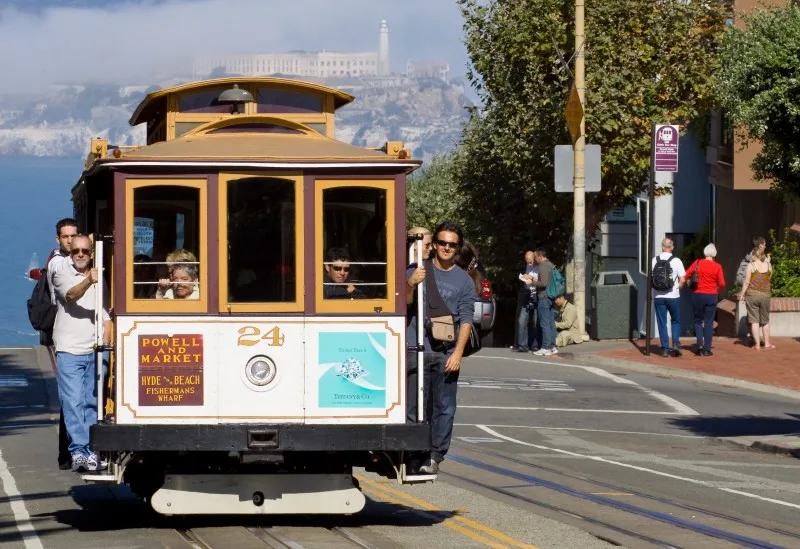
These particular sets of cable cars are very unique because they might just be the only ones of their kind still operating in the world.
The first cable cars were made available in 1873 by an entrepreneur by the name of Andrew Hallidie and kicked off operation in 1912, so yeah, more than 100 years ago! But no worries, they’re safe 🙂
There are 3 cable car lines: Powell-Hyde, Powell-Mason, and California.
At the crossing of Powell and Market Streets, there is a cable car turntable where tourists can see how cable cars work. This is the starting point for both the Powell-Mason and Powell-Hyde lines.
The two Powell cable car lines are very popular with visitors to San Francisco city and it’s usual to see long queues at the terminals.
The Powell-Mason line begins at the Powell/ Market and finishes at Bay Street at Fisherman’s Wharf.
The Powell-Hyde line ends near Ghirardelli Square, passing through Nob and Russian Hill. The line traverses the most arduous hills of the system, not far from the north of the well-known crook stretch of Lombard Street.
Both the Powell-Hyde and the Powell-Mason lines end near Fisherman’s Wharf, but the routes are quite different: read the signs on the cable cars to understand what will be the final destination.
The California line runs East-West from the Financial District to Van Ness Avenue, passing through Chinatown and Nob Hill.
A single ride will cost you $7.00, while children under 4 ride for free.
A quick tip: if you want to avoid the long queues, just catch a Powell or California line that’s already en route, along the road.
It also helps to know that cable car lines are not quite so busy in the early mornings and late in the evening, so the experience is more enjoyable.
Nonetheless, no matter the cable car line you decide to take, enjoy the breeze, the sights, and of course the bell ringing!
Muni Heritage Streetcars
To make things more complicated, San Francisco features a historic streetcar line (F-Market and Wharves) in addition to the cable cars.
You might be wondering, like I did, what’s the difference between the cable cars and the streetcars: put simply, if it has a pole connected to an overhead wire it’s a streetcar, if it doesn’t it’s a cable car. Easier now?
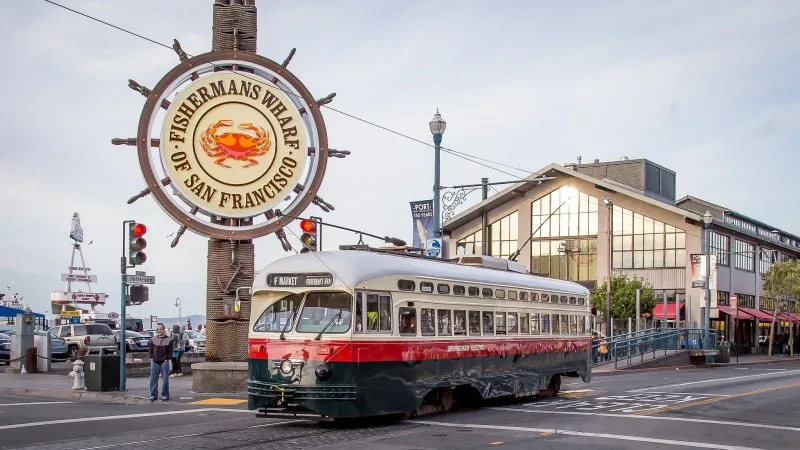
The famous F-Market and Wharves line uses historic streetcars from Milan, Zurich, and several American cities; it operates from Castro to the Ferry Building along Market Street, then moves alongside the Embarcadero to the Fisherman’s Wharf.
A single ride will set you back $3 if paid in cash (children 4 and under ride for free, youth, seniors, and people with disabilities pay $1). Just like the cable cars, it’s always crowded with tourists, but least crowded in early mornings and late evenings.
Muni San Francisco Buses & Trolleybuses
Being one of the most developed public transportation networks in the US, the Muni trolleybuses and buses run pretty much everywhere else the cable cars and streetcars don’t operate.
The buses are quite often diesel-electric hybrids while trolleybuses run on electrified overhead lines.
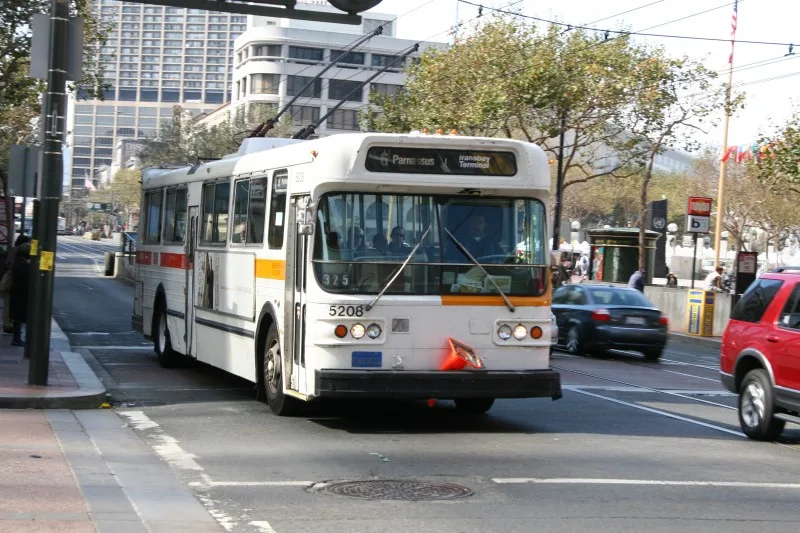
The Muni bus network includes local lines, limited-stop, and express lines.
Local lines stop at every block, while the limited-stop lines normally stop every 3 to 4 blocks. Express lines only run during peak hours and run between downtown and the outskirts of the city, mainly serving commuters to and from the Financial District.
It’s easy to reach the main tourist attractions by bus, including AT&T Park (lines 10, 30, 45, 47), Chinatown (lines 1, 10, 12, 30, 41, 91), Fisherman’s Wharf (lines 19, 30, 39, 47, 49), Golden Gate Park Museums (lines 44, 5, 16X, 71, 71L, 28, 28L, 29, 18, 33).
If you want to catch the 49ers’ football game, there are special service lines that serve Candle Park, but this service has a special fare.
One-way tickets cost $3 for adults, $1 for seniors and children 5 to 11 (children under 4 ride for free). Transferring from the Muni bus to another is free for 90 minutes after you purchase your ticket.
Most bus stops around the city showcase an electronic ‘NextBus’ display that announces arrivals in real time. Check out the Muni website for schedules and the system map.
Other Bus Agencies
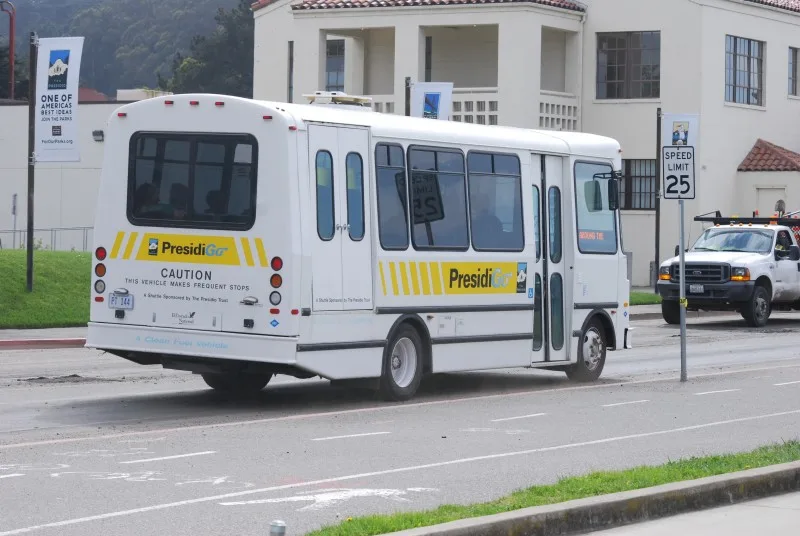
AC Transit
The AC (Alameda- Contra Costa Transit District) bus agency serves the western portions of Alameda and Contra Costa counties in the East Bay area.
The buses are usually lettered and provide constant commutes to East Bay districts, night and day; tourists might use this service to head to Berkeley. Schedules and maps are available on the AC Transit website.
A single ride costs $2.50 for adults, while one-day passes cost $5.50. If you need a transfer to Caltrain or another bus agency ask the driver to purchase a discounted ticket for your next ride.
PresidiGo
PresidiGo is a shuttle service that serves San Francisco Presidio Park.
Passengers can choose between 2 lines: one runs around the park on two different routes, which are 30-minute continuous loops. This service is free for visitors.
The Downtown Express runs between Downtown San Francisco and the Presidio, stopping at the Letterman District, Union Street/Van Ness Avenue, Embarcadero BART, and the Transbay Terminal.
Tickets for this route are free on the weekends; during weekdays no passes are required between 9.30 AM to 4 PM and after 7.30 PM.
Golden Gate Transit
Golden Gate Transit provides transportation in the northern part of the San Francisco Bay Area, primarily the Marin and Sonoma counties.
Check out the website for schedules.
Fares are calculated in zones: A one-way ticket for adults for Zone 1 costs $5.50, while Zone 2 (Sausalito, Marin City) costs $8.50. If you need a transfer to continue your trip, be sure to ask for one before paying your fare.
SamTrans
SamTrans is another San Francisco bus service that operates in San Mateo County and parts of Palo Alto and San Francisco.
Buses to and from San Francisco terminate and start their journey at Transbay Terminal. One-way tickets cost $2.50, day passes $5.
SAN FRANCISCO RAIL NETWORK
Muni Metro Light Rail
The Muni Metro is a light rail/streetcar hybrid system line, consisting of 7 lines that serve San Francisco.
It is especially useful to connect between downtown and southern/western areas; it’s easy to transfer to BART (in 4 different stations) and Caltrain (at 4th and King).
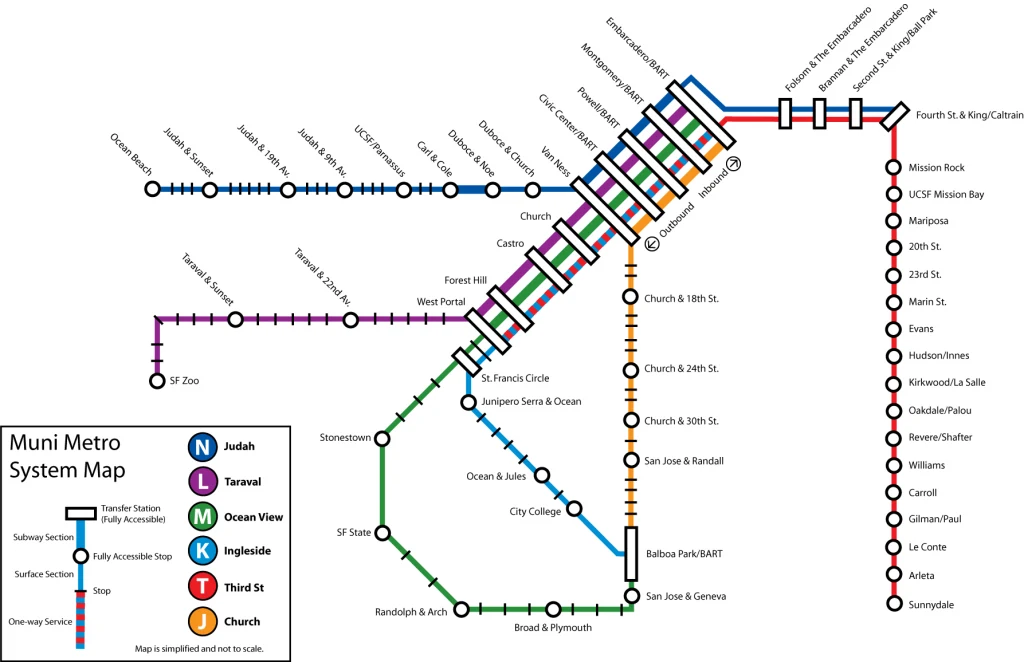
Fares for Muni Metro are the same as for buses: A one-way ticket costs $2.25 for adults and $1.00 for children aged 5–17 and seniors. You can use Muni Passport for the metro light rail as well.
You’ll probably find the N-Judah line useful to visit the famous Haigh-Ashbury neighborhood, the birthplace of the hippie culture (get off at Carl and Cole, or Carl and Stanyan), and Golden Gate Park which is also nearby.
Both the N-Judah and the T-Third serve the 2nd and King stop that is not far from AT&T Park.
Caltrain
The Caltrain provides general train service between San Francisco, Peninsula, and San Jose.
The Caltrain terminal in SF is located at 4th & King: you can easily get here by Muni’s 10 and 47 (buses) as well as by taking the 45 (trolleybus) and N or T Muni Metro lines.
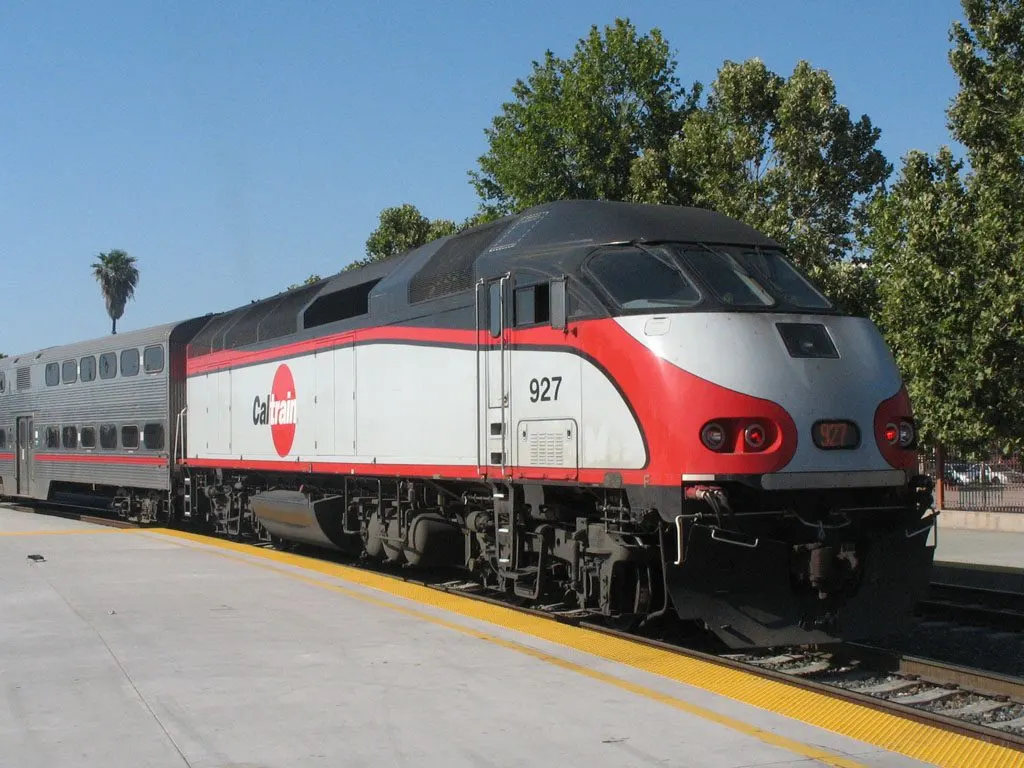
Most tourists will never use Caltrain as there aren’t that many visitor attractions along the Caltrain route, unless you want to visit the Stanford University campus.
It might be an interesting ride, though, for visitors who have already visited the usual city attractions and want to head off the beaten track.
If you sit on the west side of the train going down and the east side returning, you’ll get to see the residential areas of San Mateo, Burlingame, San Bruno, and a few others, and the industrial areas of Brisbane and South San Francisco.
There are different kinds of Caltrain trains: local, limited-stop and Baby Bullet trains.
The Baby Bullet trains are much faster (the Baby Bullet trains arrive in San Jose just about 60 minutes after leaving SF), so travel by them whenever you can.
The limited-stop trains and the Baby Bullet trains run only during peak periods on weekdays (two Bay Bullet trains a day run on weekends as well).
Caltrain fares are based on how many zones the passenger goes through: A one-way ride through one zone will cost you $3.25, $2.75 if you use a Clipper card (a reloadable fare payment card).
If you plan to use Caltrain multiple times in a day, you might want to consider a one-day pass (starting at $6.50 for one zone). Check out fares and how zones are calculated on Caltrain’s official website.
Bay Area Rapid Transit (BART)
The foremost San Francisco public transportation that operates in the Bay Area is the BART.
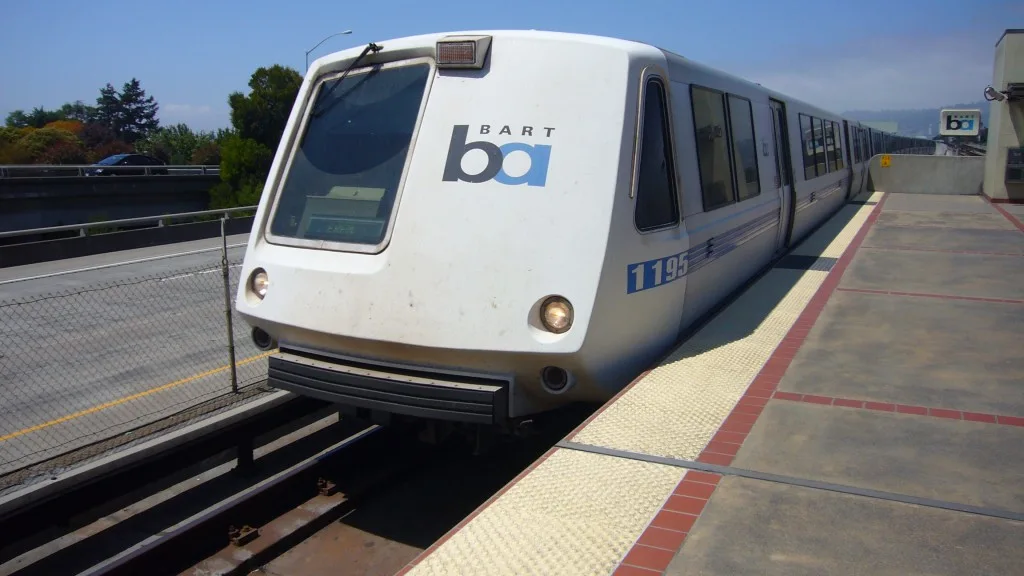
Their expansive networks of trains connect the city Peninsula, Oakland, Berkeley, Fremont, Walnut Creek, and other East Bay cities.
The BART delivers fast and very good service between the Mission District (a district with countless bars and restaurants) and downtown San Francisco (lines red, yellow, blue, green).
Other well-known destinations served by BART are the Oracle Arena (get off at the Coliseum on the green, blue, and orange lines) and the UC Berkeley Campus (line red and orange).
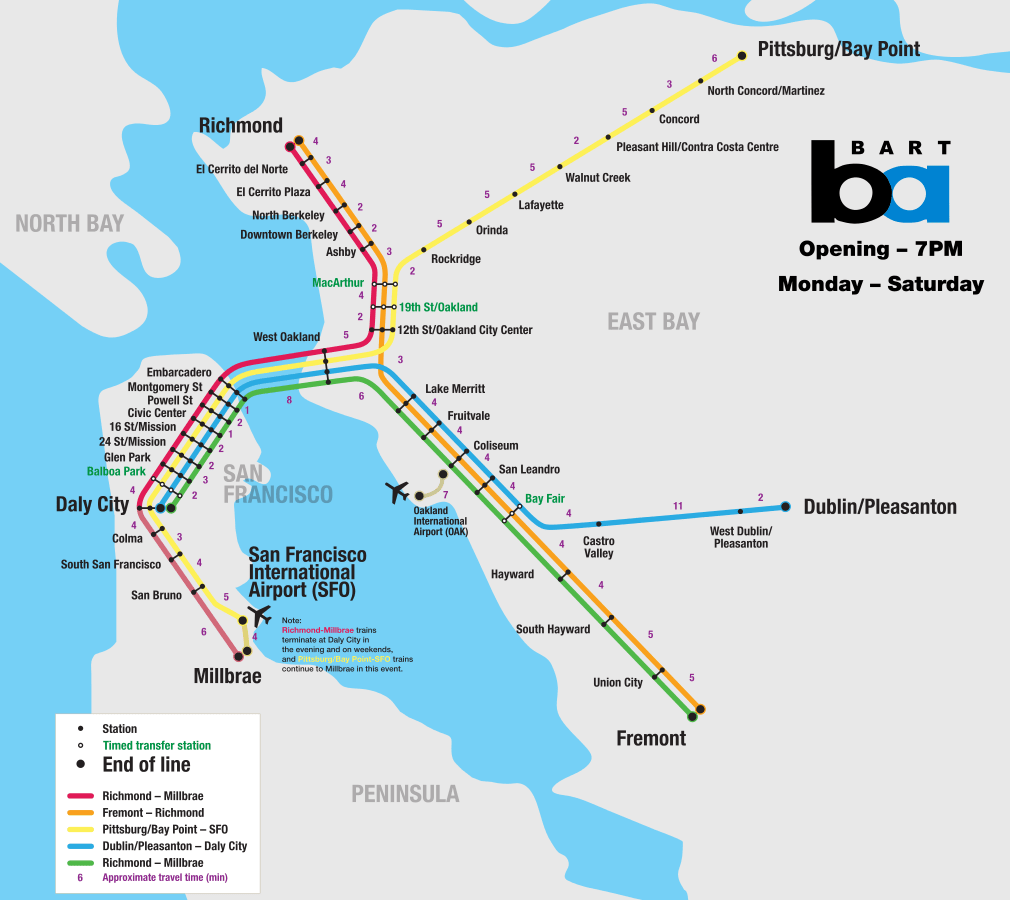
BART is useful to reach both Oakland International Airport (OAK) and San Francisco International Airport (SFO).
BART fares are set with a mileage-based formula: a one-way trip from San Francisco to Oakland costs $5.45 for adults. Calculate how much your ride will cost you with the fare calculator.
SAN FRANCISCO FERRIES
We cannot really talk about San Francisco public transportation without mentioning the ferries, can we?
For a city that lives so much on the ocean, several ferry lines offer very practical ways of getting out of the city.
The leading tourist destination points are Alcatraz & Sausalito; other ferries run to Oakland, Alameda, Angel Island, Larkspur, Tiburon, and Vallejo.
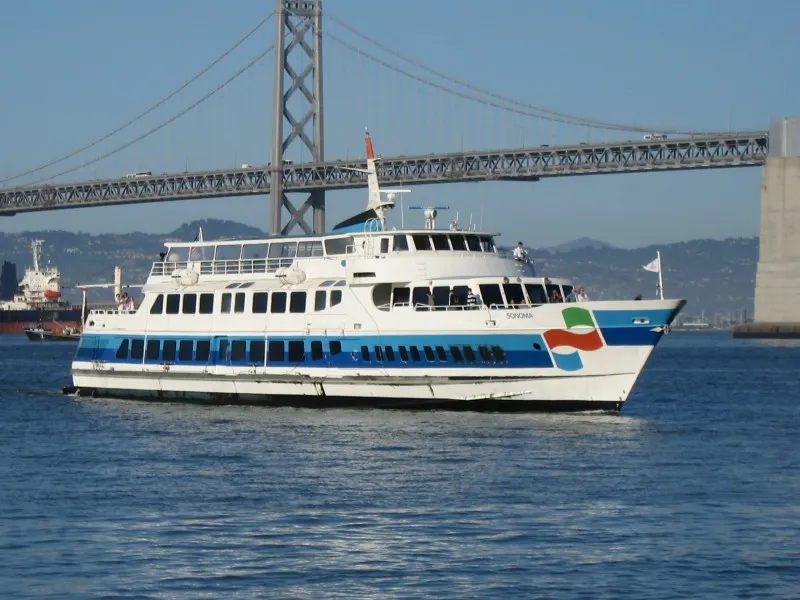
How to Get to Alcatraz by Ferry
Alcatraz is such a popular attraction that it’s better to make reservations in advance. Ferries to this destination are operated by the National Park Service, and the tickets include the ferry ride plus entrance to the Alcatraz museum and an audio guide.
Tickets aren’t cheap: they are $45 for adults, $27.55 for children 5 to 11 (children under 4 go for free), and $42.65 for seniors.
Ferries depart from Pier 33.
How to Get to Sausalito by Ferry
This is one of the world-known ferry routes with great views of the San Francisco skyline and Alcatraz. Some scenery!
The ride takes between 30 minutes and one hour and the ferry leaves either from Pier 39 with Blue and Gold Fleet (tickets are $14.75 for adults and $9 for children and seniors) or Pier 1 (The Ferry Building) with the Golden Gate ferry (tickets are $14 for adults, $7 for seniors and youth, and children under 5 years old are free).
How to Get to Oakland and Alameda by Ferry
If you’d rather take the ferry than the bus or train, a ferry service to Oakland and Alameda is available from Pier 41 or the Ferry Building.
The San Francisco Bay Ferry fleet operates hourly; a one-way ticket between Alameda or Oakland and San Francisco costs $10.75 ($8.25 with the Clipper Card) for adults.
How to Get to Angel Island by Ferry
Angel Island is mostly visited by tourists because of the presence of Immigration Station Barracks Museum and Angel Island State Park, which offers great hiking trails and some of the best views over the Bay.
Board the Blue & Gold Fleet ferry to Angel Island from the Ferry Building (Pier 1). One-way tickets cost $9.50 with Clipper, and $8 for seniors and children. Keep in mind that service during winter time is limited.
How to Get to Tiburon by Ferry
I’ve told you already why you should visit Tiburon in my previous post on off the beaten path attractions in San Francisco, now it’s time to tell you how to go!
To get to Tiburon board the Blue & Gold Fleet from Pier 41 or the Ferry Building: check out the schedule on the website.
There you have it! This is all you need to know about the public transportation system: getting around now will be very easy with this guide to San Francisco public transportation!
Looking for a place to stay in San Francisco?
Check out the best prices for San Francisco hotels here.
Do you have other tips for going car-free in San Francisco?
MORE ARTICLES ABOUT SAN FRANCISCO
A Different San Francisco: 6 Things To Do Off The Beaten Path

Meri
Monday 9th of April 2018
Excellent info over again. Thank you:)
pete4988bl.thedeels.com
Tuesday 3rd of April 2018
A dieta do abacaxi em suco funciona? http://pete4988bl.thedeels.com/facts-about-coconut-coconut-is-a-fruit-of-the-coconut-palm-which-is-botanically-known-as-cocos-nucifera-where-nucifera-means-nut-bearing
Stoneage
Tuesday 3rd of April 2018
E também você é nosso grande motivador. http://jo.hnsdfsdff.dsgdsgdshdghsdhdhfd@www.pension-gutshof-mihla.de/index.php?mod=users&action=view&id=2471995
thewindow.to
Friday 23rd of February 2018
I am truly happy to read this blog posts which includes lots of valuable facts, thanks for providing these information.
www.pip2bdiy.org
Friday 2nd of February 2018
It's going to be finish of mine day, but before end I am reading this wonderful article to improve my experience.